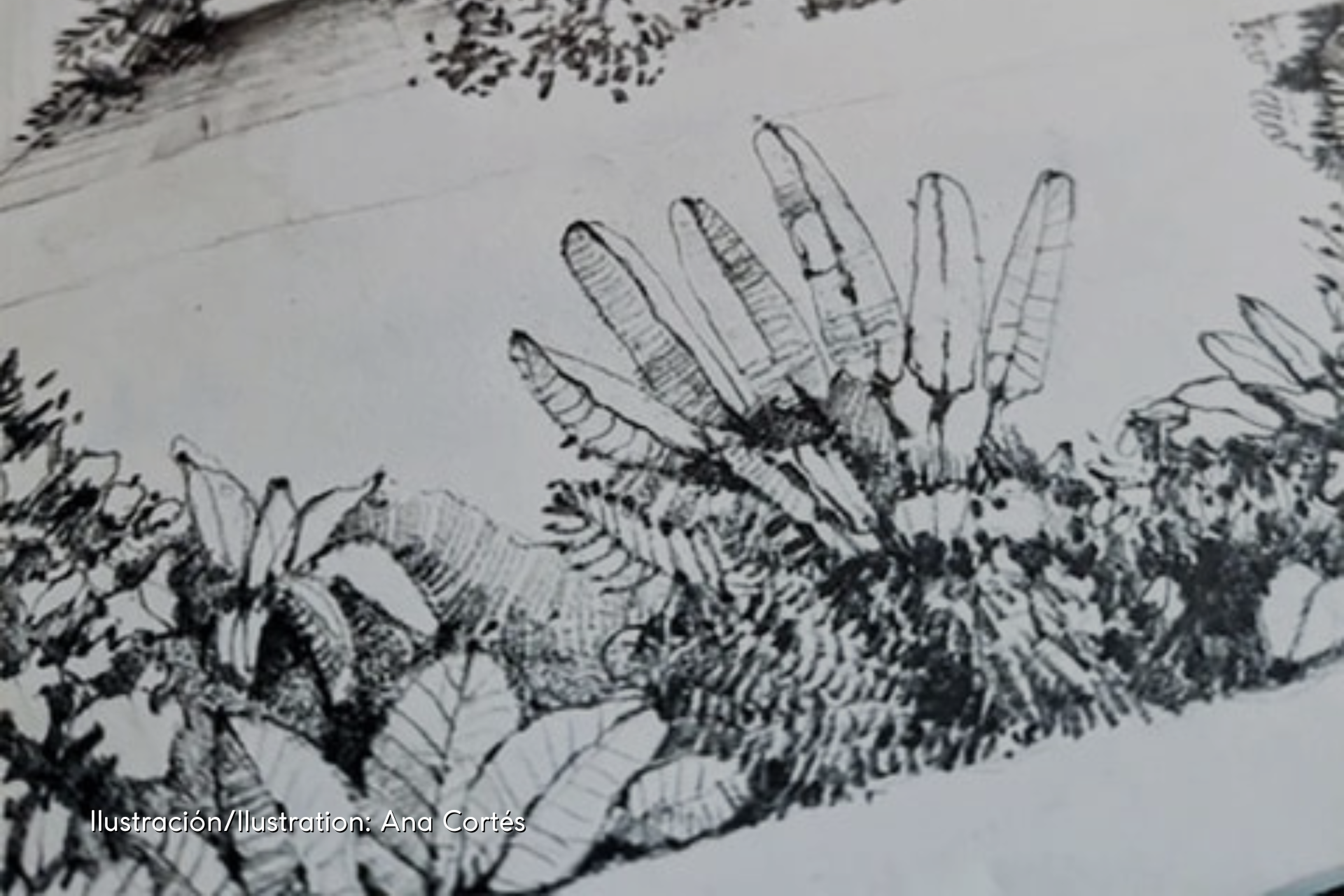
Interview with Gabriela Wiener Castillo
In the interview with landscape architect Gabriela Wiener Castillo, she answers how landscape architecture helps society feel love and respect for nature.
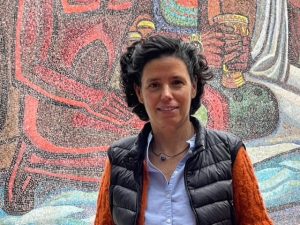
Gabriela Wiener Castillo.
Photography: Gabriela Wiener Castillo
Landscape architect (1995), Master in Architecture, Restoration of Monuments and Heritage Sites (2002), PhD candidate in Geography from UNAM. Full-time Researcher at the Center for Research in Architecture, Urbanism and Landscape of the Faculty of Architecture (CIAUP), UNAM since 2001.
She has taught in the Landscape Architecture Degree since 1995 and tutor in the Graduate Program of Sciences of Sustainability and Architecture. She is co-responsible for the Permanent Seminar on Scientific Lexicography for Architecture.
Her line of work in the area of landscape and heritage focuses on the development of projects aimed at the regeneration, planning, design and sustainable construction of the landscape. She has developed projects in the architectural, urban and regional area with the private sector, with civil groups and with the public sector.
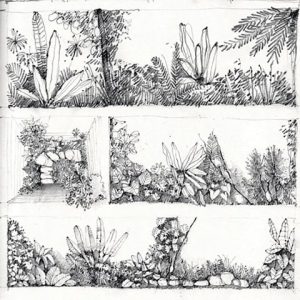
Interior garden, apartments, Cancún
Ilustration: Ana Cortés.
WHAT EXPERIENCE OR WHAT PERSON DO YOU CONSIDER CONTRIBUTED TO THE BIRTH OF YOUR LOVE FOR LANDSCAPE ARCHITECTURE?
I think there was more than one person. I have the seed from my mother’s house; however, Lilia Guzmán, Luis Enrique Ocampo and Luis Coll, friends and teachers who shared with me more than knowledge, also valuable time in talks, readings and walks, contributed to the formation of this passion.
At the risk of sounding corny, but it’s a genuine feeling, every day I fall in love with the profession and rediscover its potential. Imagine new theoretical, methodological, compositional and technical perspectives to face current challenges. Plan and re-create beautiful, resilient and sustainable spaces by mixing knowledge and tools to provide well-being but at the same time open up opportunities for better living conditions for their people by reconnecting with the land, soil, water and with their neighbors.
Likewise, I am enthusiastic about the challenge of integrating collaborative work teams with peers from other disciplines and with the inhabitants of the landscape to discuss alternatives and transition processes. A second moment occurred during the course of the doctorate in cultural geography. I found more possibilities for the profession by combining it with another field of knowledge and its particular spatial approach, listening to other discourses and ways of understanding the landscape affirmed my love for my work.

Interior garden, apartments, Cancún.
Ilustration: Ana Cortés.
IS THERE A METHODOLOGY IN THE DESIGN OF GREEN SPACES THAT ALLOWS LANDSCAPE ARCHITECTS TO CREATE A CONNECTION WITH NATURE?
Without a doubt, I dare to ensure that drawing, in addition to being a fundamental tool in itself, is a method for designing that creates an immediate connection between the designer and the place, not only with nature, but also with the people who inhabit it and decide about it.
They do not teach us to use drawing as a design method that leads us by the hand along the path of creative reflection, understanding the organization and shape of space and its compositional formulas, as well as its dynamics. This slow penetration in space by the act of drawing also reveals anomalous situations and conditions of the place and those of the context that need to be explained.
Through the lines, the relationships between the objects are debated, the possibilities of interweaving them and imagining new alternatives are raised. You discover the spatial language and the qualities of the place that is the raw material with which we will redraw and design the space.
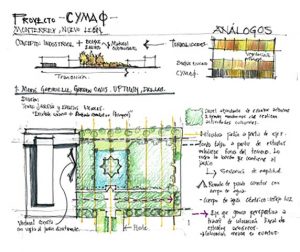
Analogues analysis, 2018.
Ilustration: Ana Cortés.
“Drawing, in addition to being a fundamental tool in itself, is a method for designing that creates an immediate connection between the designer and the place.”
IF YOU COULD TEACH LANDSCAPE ARCHITECTURE STUDENTS ONE TOOL, WHAT WOULD IT BE?
The “reading of the landscape” is in my opinion the best tool we have at our disposal. It allows us to characterize and diagnose the conditions of a place, that is, to know, understand and interpret; as well as create, innovate and design on any scale. His methods provide a multi-scale and intertextual understanding of space, considering space as a text that can be read as a whole and in layers.
They integrate the space with its people in a unit of meaning that has temporal and spatial thickness where it is possible to recognize the traces of the present, but also those of the past. Imagine it as a palimpsest that has reserved information that only a deep reading can reveal.
It is a way of approaching the landscape and describing the processes of creation and transformation of a place as a cultural process that responds to the ways of life, ideology, organization, and even conflicts of the human group that inhabits it and signifies it.
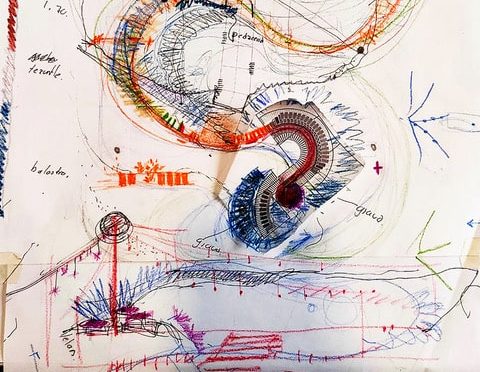
Sketch analysis of instalation, Day of the Dead offerings
Ilustration: Ana Cortés.
¿HOW DOES LANDSCAPE ARCHITECTURE HELP SOCIETY FEEL LOVE AND RESPECT FOR NATURE?
Through design. Space is a communicator of ideas and beliefs, of convictions and ways of seeing the world and others. The first contact, the most obvious way to perceive the place is by sight, so a beautiful and harmonious place is the first step to sensitize people. As said before, spaces are meant to be read and understood, which is why spaces communicate beliefs, canons of beauty and what the designer and the profession consider correct and adequate.
That is why the value we give to the components of the space is fundamental, to the raw material with which we build spaces that will dialogue with society. If our best option is to resort to the nature of the site to build them, that will be the message that users will assimilate. If the flowers and leaves of native trees, shrubs and herbaceous plants are the protagonists of the space, just like the soil, the rocks and the slopes, and this invites you to live with them and with the other living beings they attract, it is likely to trigger a feeling of respect and love for the nature of the place.
If to this repertoire we add species with additional values to the aesthetic, such as medicinal, nutritional and fiber, other meanings will be added to the message that will invite a more careful and heartfelt reflection.
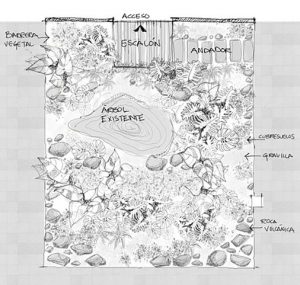
Gral. Salvador Alvarado House.
Ilustration: Xel-ha Pratts Ceron











